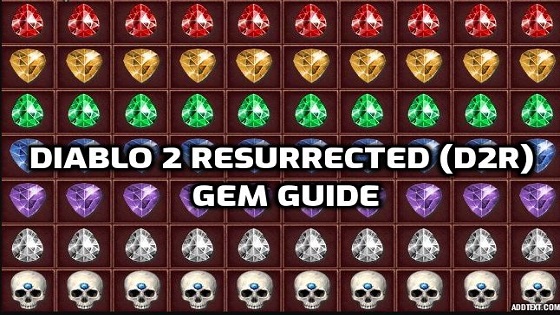You will find gems as you progress through the levels of Diablo II: Resurrected Patch 2.5 & Ladder Season 2. Gems can be obtained as loot from enemies, as loot from containers, and as rewards for completing certain quests within the game. Gems are small D2R items that can be inserted into sockets in chest armor, head armor, shields, and weapons in order to gain additional bonuses. Gems can also be used to enchant other items. In addition, several of the recipes for the Horadric Cube require them as important reagents. This guide will teach you how to improve your equipment by using Gems, as well as how to get rid of Gems that aren’t needed and how to upgrade Gems.


Gems are the only items that can be placed into item sockets for Classic players, who opt not to play with the Lord of Destruction (LoD) expansion. Jewels and Runes are only available within the expansion, so Runes and Jewels cannot be obtained outside of it. Gems continue to serve an important purpose for Expansion players, particularly when it comes to leveling gear or purchasing items that do not accept Runewords. Gems are a common type of reagent that is required for a variety of different Horadric cube recipes.
The Horadric Cube is necessary for a variety of tasks involving Gems, including the upgrading of Gems, the removal of Gems from sockets, and the socketing of equipment so that it can accept Gems. In addition to that, a number of recipes call for the use of these D2R ladder items as components.
The Fundamentals of Gems in Diablo II: As is the case with Runes and Jewels, Resurrected Gems can be placed into the appropriate sockets in one of the following four types of equipment: Chest Armor, Head Armor, Shields, or Weapons.
In order for a piece of equipment to accept a Gem, it needs to have at least one open socket. These types of armor have the potential to have sockets added to them if the Horadric Cube is used.
There are seven distinct varieties of gems, each of which possesses its own unique set of qualities: amethyst, diamond, emerald, ruby, sapphire, topaz, and skull. Amethyst is the rarest of all gems. Although the quality of the gem drops you receive will improve as the difficulty of the game increases, the chances of getting each of these types of gems as a drop remain the same. This means that you have an equal chance of getting an amethyst or a skull in any given gem drop. Even though there is a greater possibility that you will obtain drops of a higher quality as the difficulty level increases, there is still a possibility that you will obtain drops of a lower quality. Without the opportunity to receive a Chipped instead of a Perfect every once in a while, Hell simply would not be what it is.
The quality of a gem can be broken down into five categories: chipped, flawed, regular, flawless, and perfect. Examples of these categories include chipped ruby and flawless skull. The standard gems are referred to by their generic names, such as diamonds or amethysts, depending on the type of gem. The higher the level of the gem, the greater the number and quality of its features.
There are character level (cLvl) requirements that must be met in order to obtain certain types of gems. If you put a gem into an item that has a requirement for a lower minimum cLvl than the gem itself, the gem’s requirement for a minimum cLvl will increase until it matches the minimum cLvl of the item. For instance, if you put a Flawless gem with a level 15 requirement into a sword that had a level 12 requirement before, the sword will now have a level 15 requirement so that it can meet the requirements for the Flawless gem. On the other hand, this effect does not work in reverse; an item with a higher cLvl does not have its cLvl reduced to match that of a gem with a lower level.
Gems are useful at any level, but they are especially useful in the early to middle levels, when runes are still uncommon. Gems can be useful at any level. In addition to their use as currency, perfect gems are essential ingredients in a number of Horadric Cube recipes. Even at the highest levels, certain items, such as Diamonds with Resist All and Topaz with Magic Find, continue to be useful in some situations.
In contrast to runes, gems do not have a specific pattern that can be repeated to enhance their capabilities in any way. Since the powers can be stacked, having three Perfect Topaz in a Helm will grant you +72% Magic Find (+24% Magic Find x 3). This is because the powers can be stacked.
In Diablo II: Resurrected, the process of removing Gems
- Using the following recipe for a Horadric Cube, you will be able to remove Gems, as well as Runes and Jewels, from socketed equipment
- Because of this, everything that is currently in ANY of your sockets will be lost forever
- Carefully place items into sockets, and evaluate whether or not the benefits of retaining the armor outweigh the costs of doing so
Characteristics of Gems in the Game Diablo II: Resurrected
The tables that follow detail all of the characteristics and prices associated with each of the seven distinct types of gems. These are classified according to the sockets in which they are mounted as follows: Body and head armor, shields, and various types of weapons.
In the game Diablo II: Resurrected, amethysts can be found
Amethysts are a good option for melee characters because, depending on where they are socketed, they can either increase a character’s Strength, Defense, or Attack Rating.
In Diablo II: Resurrected, diamonds can be found
Diamonds have a reputation for being associated with holy light, which is reflected in the attributes of their properties such as Attack Rating, Resist All, and Damage vs. Undead. They are highly desirable for use in Shields because of the +Resist All rating that they provide. They are superior to the other resist properties offered by other gems, which only cover a single category of damage, due to the fact that they offer multiple categories.
Emeralds in Diablo II: Resurrected can either increase a character’s Dexterity or their resistance to poison, or they can increase the amount of poison damage they deal.
In Diablo II, the damage done by poison is a little strange; despite the fact that the numbers look impressive, the multiplicative damage isn’t all that spectacular. However, since poison Damage over Time (DoT) interrupts mob healing, it is common practice to use socketed weapons while leveling. This is because of the popularity of this strategy.
In Diablo II: Resurrected, rubies can be found
Depending on how they are socketed, rubies can bestow either Life or the ability to Resist Fire, as well as additional Fire Damage. Because the additional hit points from the +Life can help keep Mercenaries alive for a longer period of time, it is common practice to give these items to Mercenaries.
In Diablo II: Resurrected, Sapphires can be found
The maximum amount of additional Mana, Cold Resistance, or Cold Damage that can be gained from Sapphires is increased. Due to the fact that the Cold Damage causes a slowing effect, these are very popular among characters of lower levels.
Skulls are a unique item in Diablo II: Resurrected Skulls. This is due to the fact that they provide double bonuses for both body and head armor, as well as for weapons.
These provide the benefits of Replenish Life and Regenerate Mana, deal damage to the attacker in the form of thorns, or function as a dual leech, stealing both Life and Mana. Although it is overshadowed by later options, the leech effect is by far the most popular, particularly early on in the game.
Gem Shrines
It is possible for you to come across a unique and uncommon variety of Shrine known as a Gem Shrine. When you click on Gem Shrines, they will either do the following or neither of the following:
If you do not currently possess a Gem in your inventory, it will return a gem of a random variety that is of the Chipped quality.
It will upgrade one of the gems in your inventory at random if you have one or more gems already in your inventory.
Don’t go blindly clicking on the Gem Shrine without having a strategy! If you have the Horadric Cube and can upgrade any of the gems in your collection, make sure that your best gem is upgraded to the highest possible quality. If at all possible, get it upgraded to Flawless, but don’t go all the way to Perfect. (It is also a good idea to store high quality gems in your shared stash, so that even low-level alts who discover a Gem Shrine will be able to upgrade your best gems. Keep in mind that shrines, including gem shrines, can appear in the first act of Normal.)Click the Gem Shrine once you have made certain that the gem you wish to upgrade is the only gem currently held in your inventory. Do not squander this chance to improve your account at no cost!
Be wary, as well, because it will instead spit out a chip if you have a Perfect Gem or Skull in your inventory at the time. There is no way to improve on Perfect.
















